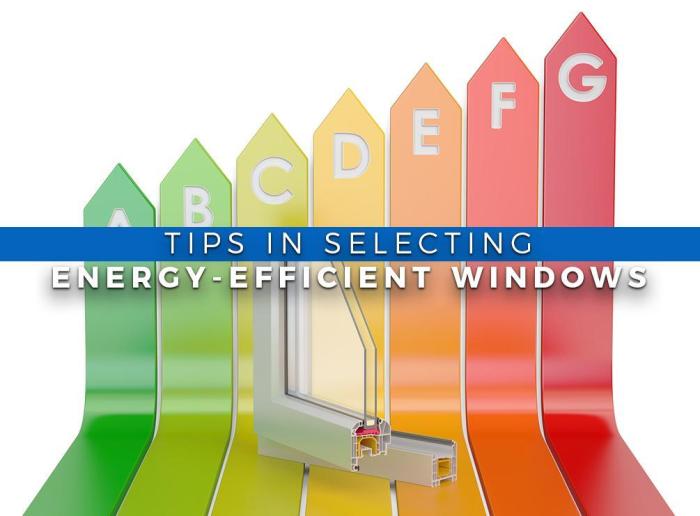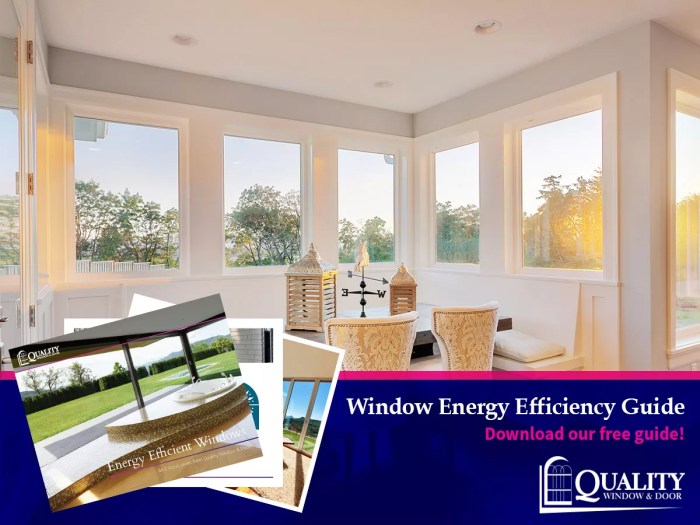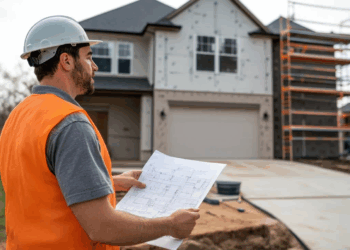
Exploring the realm of energy efficiency in windows, this guide delves into the significance of upgrading to new windows for a more sustainable future. With a focus on reducing utility bills and enhancing environmental impact, readers are bound to discover the key benefits of embracing energy-efficient windows.
Delve deeper into the realm of energy-efficient windows with this informative guide that sheds light on the types available, installation processes, maintenance tips, and more.
Importance of Energy Efficiency in Windows
Energy efficiency in windows plays a crucial role in reducing utility bills and creating a more sustainable environment.
Benefits of Energy-Efficient Windows
- Improved insulation to reduce heat loss in winter and heat gain in summer.
- Low-E coatings to block harmful UV rays while still allowing natural light.
- Double or triple glazing for better thermal performance.
- Argon or krypton gas fills to enhance insulation properties.
- Quality weather-stripping and sealing to prevent air leakage.
Types of Energy-Efficient Windows

When it comes to energy-efficient windows, there are several types available on the market. Each type offers unique benefits and features that cater to different needs and climates.
Double-Pane Windows
Double-pane windows consist of two layers of glass with a space filled with air or gas in between. These windows provide better insulation compared to single-pane windows, reducing heat transfer and energy loss. They are a cost-effective option for improving energy efficiency in moderate climates.
Triple-Pane Windows
Triple-pane windows have three layers of glass with two spaces filled with gas. These windows offer superior insulation and energy efficiency, making them ideal for colder climates where heating costs are a concern. They provide better sound insulation as well.
Low-E Glass Windows
Low-E (low emissivity) glass windows have a special coating that reflects infrared light while allowing visible light to pass through. This helps in blocking UV rays and reducing heat transfer, improving energy efficiency. Low-E glass windows are suitable for all climates and help in maintaining a comfortable indoor temperature.
Gas-Filled Windows
Gas-filled windows have argon or krypton gas filled in between the glass panes, which provides better insulation than air. These windows help in reducing heat transfer and improving energy efficiency. Gas-filled windows are recommended for areas with extreme temperatures.Choosing the most suitable type of energy-efficient window depends on various factors such as climate, location, budget, and personal preferences.
It's essential to consider these factors before making a decision to ensure maximum energy savings and comfort in your home.
Installation Process for New Energy-Efficient Windows
When installing new energy-efficient windows, it is crucial to follow a detailed process to ensure maximum efficiency and effectiveness. Proper insulation and sealing play a significant role in the overall performance of these windows, preventing air leaks and maintaining a comfortable indoor environment.
Let's explore the steps involved in the installation process and the importance of insulation and sealing
Steps for Installation of Energy-Efficient Windows
- Measure and prepare the window opening accurately to ensure a perfect fit for the new window.
- Remove the old window carefully, making sure to clean the area and repair any damage to the frame.
- Apply a high-quality sealant around the window opening to prevent air leaks and improve energy efficiency.
- Install the new energy-efficient window securely, making sure it is properly aligned and sealed in place.
- Add insulation around the window frame to enhance energy efficiency and reduce heat transfer.
- Check for any gaps or leaks after installation and make necessary adjustments to ensure a tight seal.
Professional Installers vs. DIY Installation
While some homeowners may opt for a DIY approach to save money, hiring professional installers for energy-efficient windows can offer several benefits. Professionals have the expertise and tools to ensure proper installation, including precise measurements, secure sealing, and efficient insulation.
They can also identify any issues during the installation process and address them effectively. On the other hand, DIY installation may lead to errors, inadequate sealing, and reduced energy efficiency in the long run.
Maintenance and Longevity of Energy-Efficient Windows

Proper maintenance is crucial to ensure the optimal performance and longevity of energy-efficient windows. Here are some tips to help you maintain your windows effectively.
Maintenance Tips for Energy-Efficient Windows
- Regularly clean the windows using a mild detergent and water to remove dirt and grime that can impact their efficiency.
- Inspect the seals and weatherstripping for any signs of wear or damage, and replace them if needed to prevent air leaks.
- Check for any cracks or gaps in the window frames and fill them with caulk to improve insulation.
- Ensure the hardware, such as locks and hinges, are functioning properly to maintain the security and efficiency of the windows.
Longevity of Energy-Efficient Windows
Energy-efficient windows are designed to last longer than traditional windows due to their advanced materials and construction. While the lifespan can vary depending on factors like quality of installation and maintenance, energy-efficient windows generally have a longer lifespan of 15 to 20 years compared to traditional windows.
When to Replace Energy-Efficient Windows
- Consider replacing energy-efficient windows when you notice condensation between the panes, which indicates a broken seal and reduced insulation.
- If you feel drafts or cold spots near the windows, it may be a sign that the windows are no longer providing adequate insulation.
- Older energy-efficient windows that are nearing the end of their lifespan may start showing signs of wear and reduced efficiency, prompting the need for replacement.
Final Thoughts
In conclusion, the journey through the realm of energy-efficient windows unveils a world of possibilities for homeowners looking to enhance their living spaces. With a focus on sustainability and cost savings, the decision to invest in new windows is a step towards a greener future.
Frequently Asked Questions
How can energy-efficient windows reduce utility bills?
Energy-efficient windows help to better insulate your home, reducing the need for heating or cooling, which in turn lowers energy consumption and utility costs.
What are the benefits of triple-pane windows compared to double-pane windows?
Triple-pane windows offer enhanced insulation and noise reduction compared to double-pane windows, making them more energy-efficient and comfortable.
Is DIY installation of energy-efficient windows recommended?
While some experienced individuals may opt for DIY installation, it's generally recommended to hire professional installers to ensure proper sealing and insulation for optimal energy efficiency.
When should energy-efficient windows be replaced for maximum efficiency?
Energy-efficient windows should be replaced when signs of wear or damage are noticeable, or when newer, more advanced energy-efficient technologies become available for better performance.











